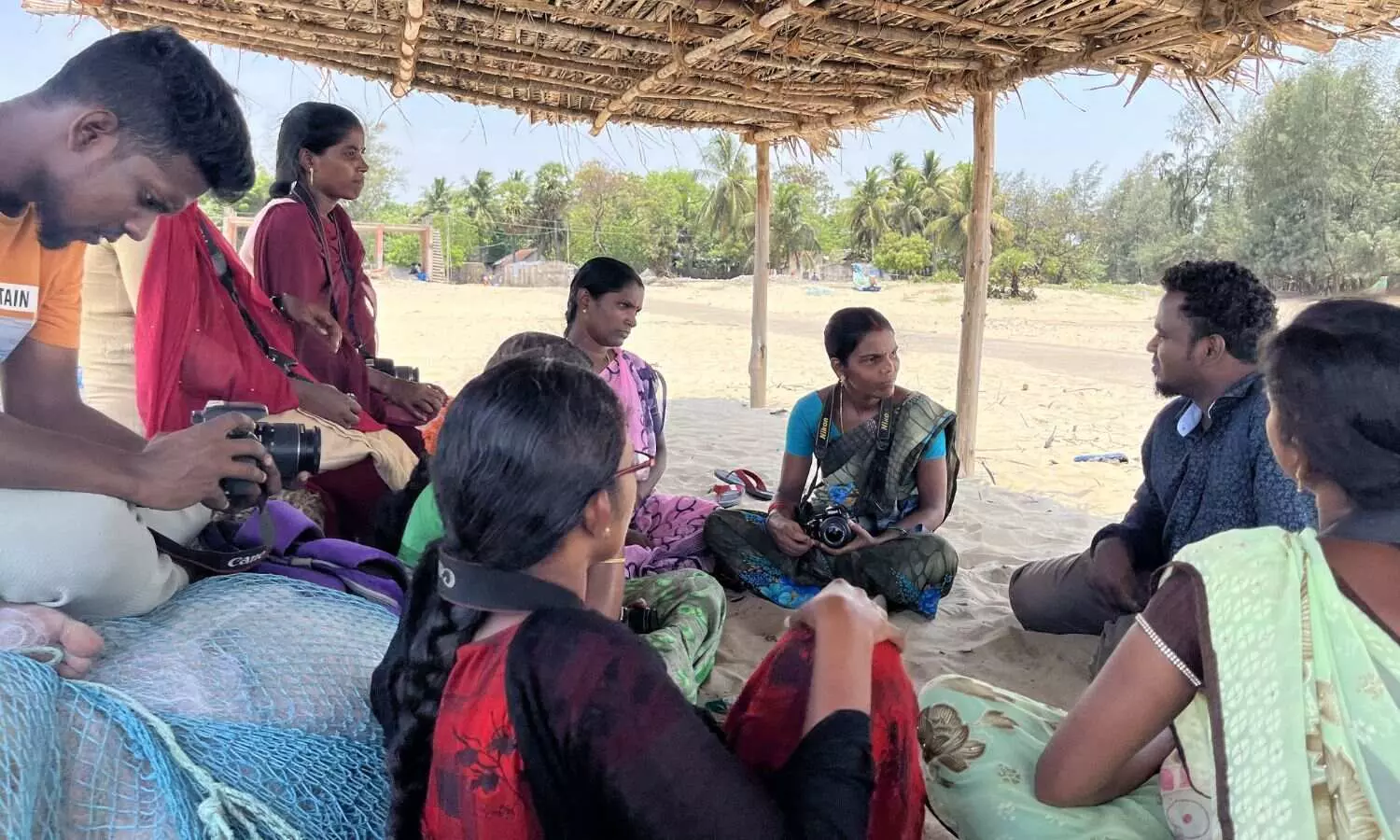TN fisherwomen turn photographers, chronicle life between tide and shore
This exhibition will feature pictures captured by the fisherwomen from Nagapattinam and Odisha of the life of Boopathi amma, who lost her husband to the Sri Lankan navy, a fisherman, who was on the verge of amputating his leg because of over-exposure to salt water, toils of migration, erosion and much more;

During the training
CHENNAI: One and half years ago, the Dakshin Foundation initiated an exclusive workshop for fisherwomen and approached photographer Palanikumar to mentor the folks from Nagapattinam and Odisha. However, the workshop went in vain, which Palanikumar found it difficult to accept.
With the support of Pari Network, Dakshin Foundation and his friends, he is organising an exhibition, titled Chronicle Of The Tides, capturing the stories of migration within the country's waters, climate and conflict. “I didn’t want to stop with just training them. I wanted to take this forward and create a space for them to tell their own stories to the world. An NGO called Sneha, which entirely operates to uplift the women from the fishing community, coordinated at Nagapattinam. All the images are impactful and are statements by themselves,” begins Palanikumar, who provides training to people interested in photography at his Palani Studio. He also provides the necessary equipment like cameras to hone their skills.

Children enjoying the serene weather and calming waves
Instagram is filled with images of many fishermen and women on beaches, shot by photographers. “But these pictures will tell a completely different story. It encapsulates the hard work of the women, the stereotypes they have to break and how their occupation takes a toll on their health. It is the narratives of fisherwomen through the lens of fisherwomen. I am emotionally connected with this project because my mother was a fish vendor,” adds the 33-year-old.
The seashores and lives of fishing communities are entirely different in both Nagapattinam and Odisha. “Erosion happens daily there. A fisherwoman has incredibly documented this and how things change because of the calamity,” he shares. The training period was for three months. “Even today, many women in these communities are not allowed to take up photography and I hope this exhibition will break the stereotypes and provide the deserved opportunities,” he says.
Taking time off for a meal as the salty air whispers
Ever seen a fisherwoman carrying a 'kattapai' (big shopper) in one hand and a camera in the other hand? This is how these women travel to capture the rustic moments. The entire village was astonished to see young women with cameras.
Another important and hardly-discussed topic about fishing is the amount of migration. “It is rare to see something in the visual medium about the fisherfolk community. Migration is very high. In Nagapattinam, people from the community are migrating to Kerala and from Odisha they are shifting to Gujarat. Till today, the fishing village in Gujarat uses paddle boats and not motors. All these have a larger picture to them and we have tried to capture the migration, environment, climate, border issues and more. This will create a discussion in the society,” Palanikumar believes.
Fisherwomen carrying huge loads on their heads
Clicking these pictures was not a cakewalk for the women. They have to go through many judgemental talks to come out with flying colours. “In our community, women are not allowed to take photography as a profession or a hobby. But my husband supported my decision and convinced our family. I have tried to capture the everyday struggles of fish vendors and whether all their efforts are profiting them. We are allowed to wear only sarees and travel to various places with our cameras. I was mocked by people and pushed into a traumatic space. Thanks to my mentor, Palanikumar sir for supporting and motivating me to break the filthy laughs and move forward,” states a proud Mahalakshmi, one of the participants.
Talking about her photography journey, the housewife explains, “I documented the inspiring journey of two young women who lost their husbands at a very young age. Surviving and tackling the male gaze and pitiful words of the society to earn their living was quite traumatizing when I traveled with them to capture their lives.”
Making of karuvaadu
Another photographer, Suganthi followed the life of her father, who has been into fishing since her childhood. “His legs became numb because of overexposure to salt water and extreme weather conditions. We all were broken and even now he is working,” says Suganthi with a painful smile. Though interested in photography, she is now preparing for competitive exams due to financial constraints.
Set to sail for fishing
Many in the city hear about the attack of the Sri Lankan navy on Tamil fishermen. But the aftermath effect on the family remains unheard and unnoticed. “My friend’s mother, Boopathi amma, is a mother of five girls and one son. She lost her husband to the brutal attack of the Sri Lankan navy in 2000. One person returned to the shore, escaping the shootout, but still in the trauma. Since then, Boopathi amma has been the only breadwinner of the family and her only son also gave up his life due to drug addiction. I capture the difficulties of amma, which is filled with emotions, perseverance and hardwork. She was in tears while opening up about the struggles she faced to raise her children,” elucidates a teary-eyed Suganthi.
“I hope that this project will open doors for them to speak about their lives, and shed light on their pain in various forums. I will use photography as a powerful tool to voice out about the denied rights to minority communities and those in need,” concludes Palanikumar.
Kesavan, a fisherman, throwing a casting net
The seven-day photo exhibition, Chronicles Of The Tide, is on from September 23 at Lalit Kala Akademi, Thousand Lights.

